Introduction to Neijing Classical Acupuncture Part I: History and Basic Principles
ARTICLE
First published in Journal of Chinese Medicine
Number 100 (October 2012)
Classical Chinese medical texts represent the foundation for all traditional Chinese medical theories and practices. Written over two thousand years ago, these documents set forth and define the basic principles of Chinese medicine and the clinical practice of acupuncture. They represent a critical and comprehensive resource for the modern practitioner. Despite their importance, the fundamental principles contained within these texts remain poorly understood and rarely used in modern clinical practice.

